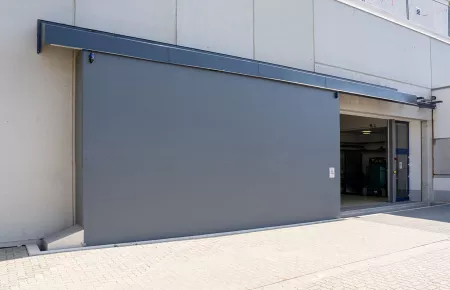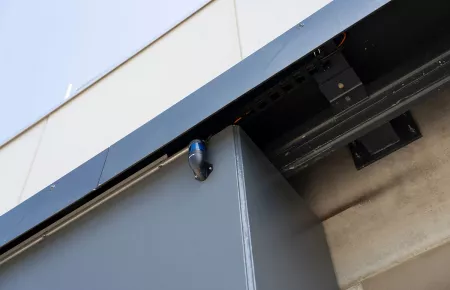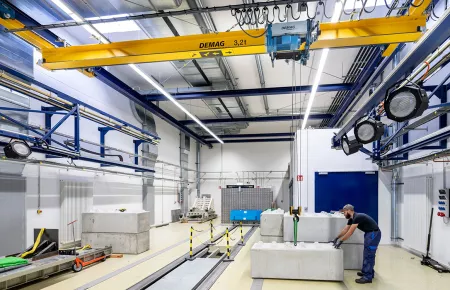
How do you move a 66.2-tonne heavy-duty door?
Stahlbau Wentz uses the Demag modular drive range
Door drive for XXL inspection system
The company
Where other steel construction companies reach their limits, the specialists at Stahl-Projektbau Wentz GmbH come to the fore. Founded in Goslar in 2005, the company designs and builds pipe bridges, substructures and special structures, among other things. The company's portfolio includes complete industrial buildings as well as test benches and process plants.
One of Stahl-Projektbau Wentz's areas of expertise is radiation protection cabinets, for industry and research in particular. These cabinets, which are always individually designed, are used for housing material testing systems, electron accelerators and much more besides. They shield the environment from radiation and at the same time ensure easy access, such as through large sliding doors.
Requirement
Stahl-Projektbau Wentz received a request from a research institute in southern Germany for the housing of a complex X-ray inspection system for very large components – including entire vehicles.
The entrance needed to be correspondingly large: 7.48 m wide and 4.25 m high. Due to radiation protection regulations, the materials and material thicknesses were also very specific. All of this makes the sliding door very heavy – 66.2 tonnes, to be exact.
Among other things, the challenge was ensuring the heavy sliding door was mobile and could be moved and closed with precision. At the same time, the necessary drives had to be integrated into the door in such a way that when closed, no rays could penetrate outside the enclosure.
Solution
Wentz knew which drives to use for this task during the design process – the Demag modular drive range. The combination of electric drive and wheel block can be optimally configured for heavy-duty applications. Demag travel wheels, which are integrated into a robust and compact housing, can be combined with various electric and geared motors as well as frequency inverters from the Demag modular drive range.
The wheel block system has been used hundreds of thousands of times around the world – not only to move crane systems with precision, but also, for example, in intralogistics (heavy-duty transport carriages) or as architectural features in building construction with movable roof and facade structures in stadiums and swimming pools.
The radiation protection door uses four DRS 315 wheel blocks in combination with a compact angular geared brake motor (0.75 kW output and 1410 rpm motor speed) as a central drive and a Dedrive Compact frequency inverter. Two wheel blocks are installed next to each other on a pair of rails.
This precisely controlled "four-wheel drive" ensures uniform, vibration-free movement of the heavy radiation protection door. And it is extremely energy-efficient. Using just 0.75 kW of power, the 66.2-tonne door can be moved. The load spectrum of the DRS wheel block series ranges up to 40 tonnes per wheel block.
Special features
The Demag drive uses speed control to generate a very high torque from stand-still in order to set the heavy sliding door in motion without jerking and to move it smoothly. The speed is infinitely variable. At the end of the movement process, the rotary limit switches of the drives support very precise positioning to the stopping point.
The heavy-duty door drive is not the research institute's first project with Demag drive technology. A Demag single-girder overhead crane from the EPDE range has been in operation in the building with the X-ray inspection system since 2012. This transports test environment components and supports the test engineers in converting the system for various test scenarios. The entire building area can be utilised as the crane was factored into the planning of the hall. The crane runways are integrated into the building in such a way that the trolley approach dimension reaches up to the hall walls.
With a span of 8.1 metres and a load capacity of 3.2 tonnes, the test objects are easily transported by the EPDE suspension crane and precisely positioned with a Demag DRC-10 radio controller. The test engineers can even use the crane as a weighing device using its tare function. A bypass control system acts on the crane electric equipment to prevent the crane from entering unwanted sections of the test workshop.
Your contact

Christoph Kreutzenbeck
Ruhrstrasse 28
58300 Wetter
Germany
Image gallery
Image gallery











